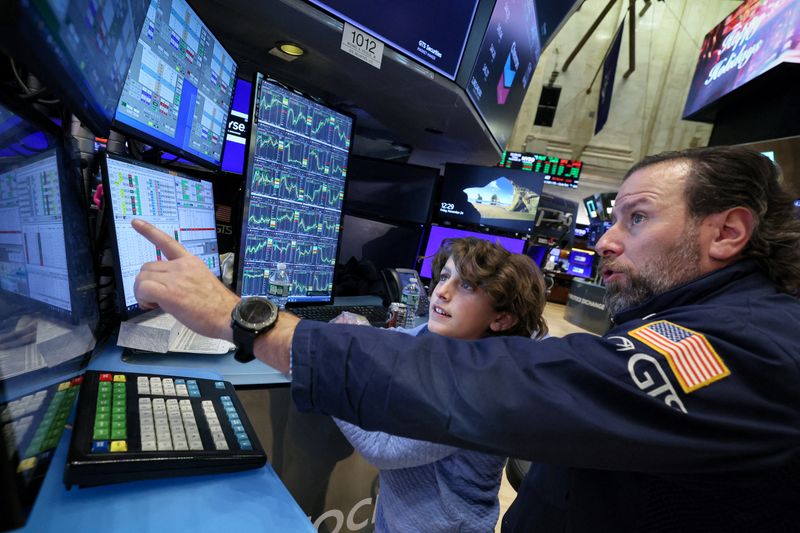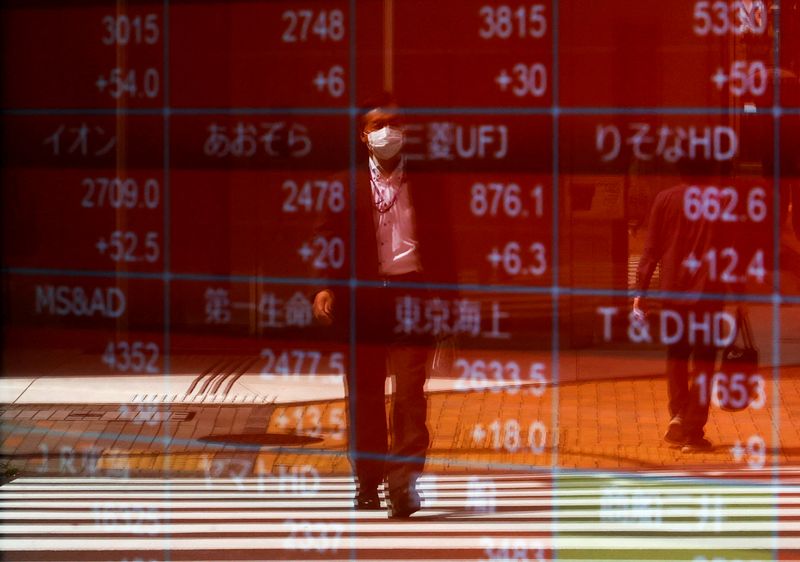By Sinéad Carew and Marc Jones
NEW YORK/LONDON (Reuters) -MSCI'S global stock index rose on Thursday while the Dow closed at its highest level since mid-January 2022, and bond yields and the dollar gained after Federal Reserve officials sounded caution about interest rate cuts.
The U.S. Commerce Department said consumer spending, which accounts for more than two-thirds of U.S. economic activity, increased 0.2% last month in line with economists' expectations. The annual inflation increase was the smallest in more than 2-1/2 years, signaling cooling demand.
U.S. Treasury yields climbed even after economic data provided more evidence that the Fed could end rate hikes. After a sharp decline in recent weeks, the benchmark 10-year yield is on pace for its biggest monthly drop since August 2011.
The dollar gained as investors took profits on bets it would weaken further and shrugged off economic data suggesting the Fed could be done hiking rates.
"Just about all the data today was favorable for investors. Most importantly, we continue to see a deceleration in the Fed's preferred measure of inflation, the core PCE price index," said Russell Price, chief economist at Ameriprise Financial (NYSE:AMP) Services Inc, in Troy, Michigan. He said this "should be a good thing for Fed decision-making in the next few meetings."
While the closely watched U.S. inflation data was in line with economists' expectations, some traders appeared to have priced in slower inflation, said John Augustine, chief investment officer at Huntington Private Bank.
"The market was anticipating that there would be a downside surprise, that inflation would come down faster and spending would fall faster than consensus," said Augustine.
Also on Thursday, Fed policymakers offered mixed messages with pushbacks on investor bets for a quick pivot to rate cuts.
New York Fed Bank President John Williams said if price pressures and imbalances persist "additional policy firming may be needed." And San Francisco Fed President Mary Daly said she is thinking about whether policy is "sufficiently restrictive to restore price stability" rather than about rate cuts.
MSCI's gauge of stocks across 47 countries rose 0.2%, on track for a monthly gain of 9%, after three straight months of declines. This would mark its biggest monthly percentage increase since 2020 when investors reacted to the first COVID-19 vaccine breakthroughs.
Earlier the pan-European STOXX 600 index had closed up 0.55%, confirming its biggest monthly percentage gain since January as weak economic data from Europe bolstered bets for rate cuts.
The Dow Jones Industrial Average rose 520.47 points, or 1.47%, to 35,950.89, the S&P 500 gained 17.22 points, or 0.38%, at 4,567.8 and the Nasdaq Composite dropped 32.27 points, or 0.23%, to 14,226.22.
The Dow, which is an index of 30 blue-chip U.S. stocks, hit its highest intraday level so far in 2023 and registered its biggest monthly percentage gain since October 2022. Its biggest boost came from Salesforce (NYSE:CRM) Inc after the company's strong quarterly report.
Yields in U.S. Treasuries and bonds of other major countries have tumbled in November from peaks of more than a decade in October. U.S. Treasury yields, which usually drive global borrowing costs, have fallen the most since 2008.
On Thursday, benchmark 10-year notes were up 7.1 basis points at 4.342%, from 4.271% late on Wednesday. The 30-year bond was last up 5.8 basis points to yield 4.509% while the 2-year note was up 5.5 basis points to yield 4.703%.
In currencies, the dollar index rose 0.681%, with the euro down 0.76% to $1.0885.
The Japanese yen weakened 0.66% versus the greenback at 148.21 per dollar, while Sterling was last trading at $1.2624, down 0.55% on the day.
In energy, oil prices settled lower after OPEC+ producers agreed to first-quarter oil output cuts that fell short of market expectations.
U.S. crude settled down 2.44% at $75.96 per barrel and Brent ended at $82.83, down 0.32% on the day.

Gold prices fell on Thursday but eyed a second straight monthly gain as expectations the Fed could cut interest rates enhanced the appeal of non-yielding bullion.
Spot gold dropped 0.4% to $2,035.94 an ounce. U.S. gold futures fell 0.52% to $2,036.40 an ounce.
